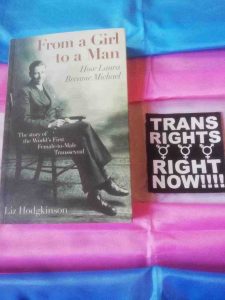By Jem Knight, BA History, Level 2
I had only recently come out as transgender when I ventured into Gay’s the Word bookshop in London for the first time. To say that stepping in there was an emotional experience would be a great understatement. Being a history lover I naturally gravitated to the non-fiction segment of the shop and found myself face to face with Liz Hodgkinson’s book From a Girl to a Man: How Laura Became Michael. This book follows the life of Michael Dillon, a trans man who was the first ever person to undergo full gender reassignment surgery, including phalloplasty. I bought it, along with a few other books, and immediately found myself engrossed in finding out about this fascinating man.
Dillon was born on 1st May 1915, into an aristocratic family and was the child of Sir Robert Dillon, heir to the baroncey of Lismullen. Unfortunately the birth of Dillon led to his mother’s death and he and his older brother, Robert “Bobby” Dillon, were raised by their aunts whilst their father succumbed to alcoholism. Through Hodgkinson’s book readers are able to see Dillon’s life unfold, from his childhood with his brother, to his university life and on to his working life as a surgeon, finally leading to his turn to Buddhism and his ordination as a Buddhist monk. All of this explored through the lens of his gender identity and his journey through the gender reassignment process at a time when there was little information on what it meant to be transgender.
Hodgkinson’s book may not be what a reader might expect when looking at the history of a trans person. She is very open in exploring Michael’s early life as he was known before his name change and numerous procedures. She looks at Dillon as Laura, Michael’s birth name, and studies Laura’s early life and the processes in which Dillon realised he was transgender. Hodgkinson is open in using the pronouns Michael was assigned at birth (she/her) when looking at his early life and incredible academic career at Oxford University, in which alongside studying, Dillon brought women’s rowing up from the ashes and transformed it into a sport that was on par with its male counterpart. Only after this, when Michael went on to openly refer to himself as male and make the push to explore treatment does Liz switch to referring to Dillon as Michael and using male pronouns. I believe that this is a powerful way to tell Dillon’s story, especially from a historical viewpoint. It opens up the timeline of his life and his own exploration into his identity. It shows the reader different points in Dillon’s life where he questioned himself and opened himself up to the idea of being transgender. For me as a trans person it gave me a personal connection to Dillon as I recognised many of the stages he went through as ones I also have, albeit decades apart. It shows a commonality between trans people that transcends time and highlights that the trans struggle is not as recent an occurrence in history that many might believe.
If you have any interest in transgender history I would wholeheartedly recommend Liz Hodgkinsons book on the life of Michael Dillon as he was a figure who did an incredible amount for the development of gender reassignment surgery by being the first to undergo phalloplasty. Hodgkinson delivers the details of Dillon’s life with compassion and brings to life the character of the man who gave everything to become himself in a society that was not ready for him to do so.
References
Liz Hodgkinson, From a Girl To Man: How Laura Became Michael. The Story of the Worlds First Female-to-Male Transsexual, (London, 2015).
Images
Author’s own image.
